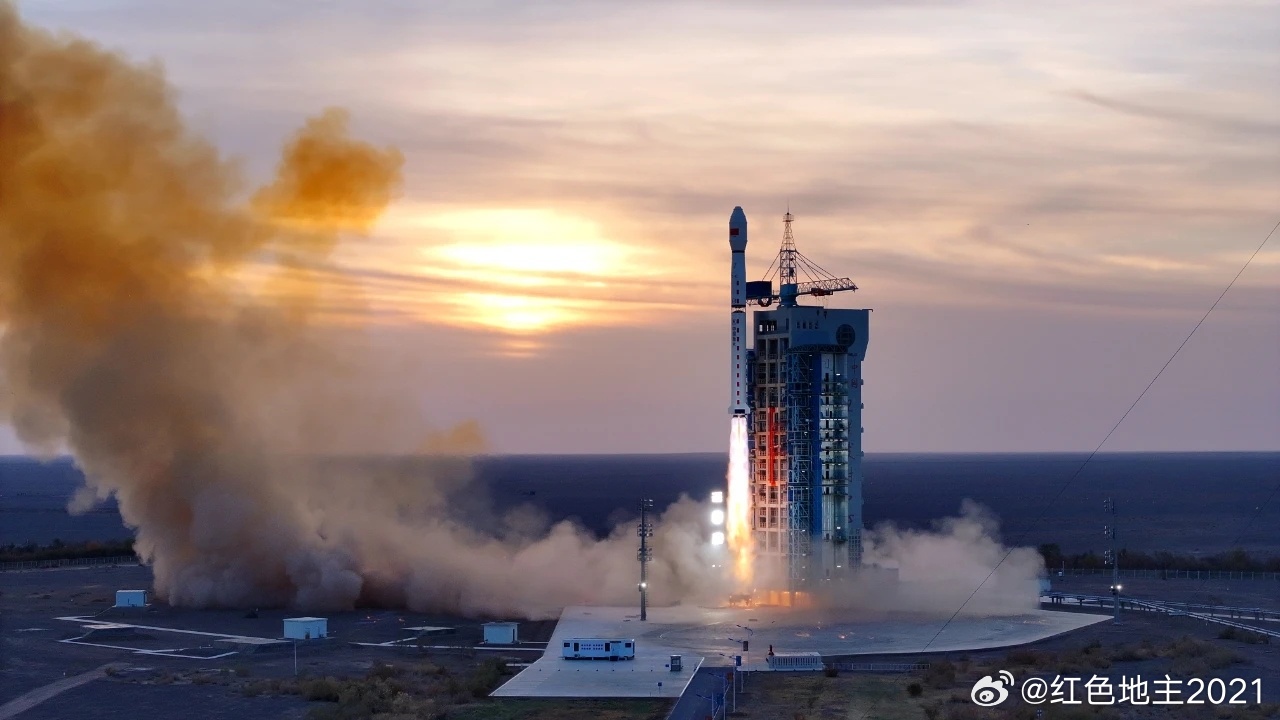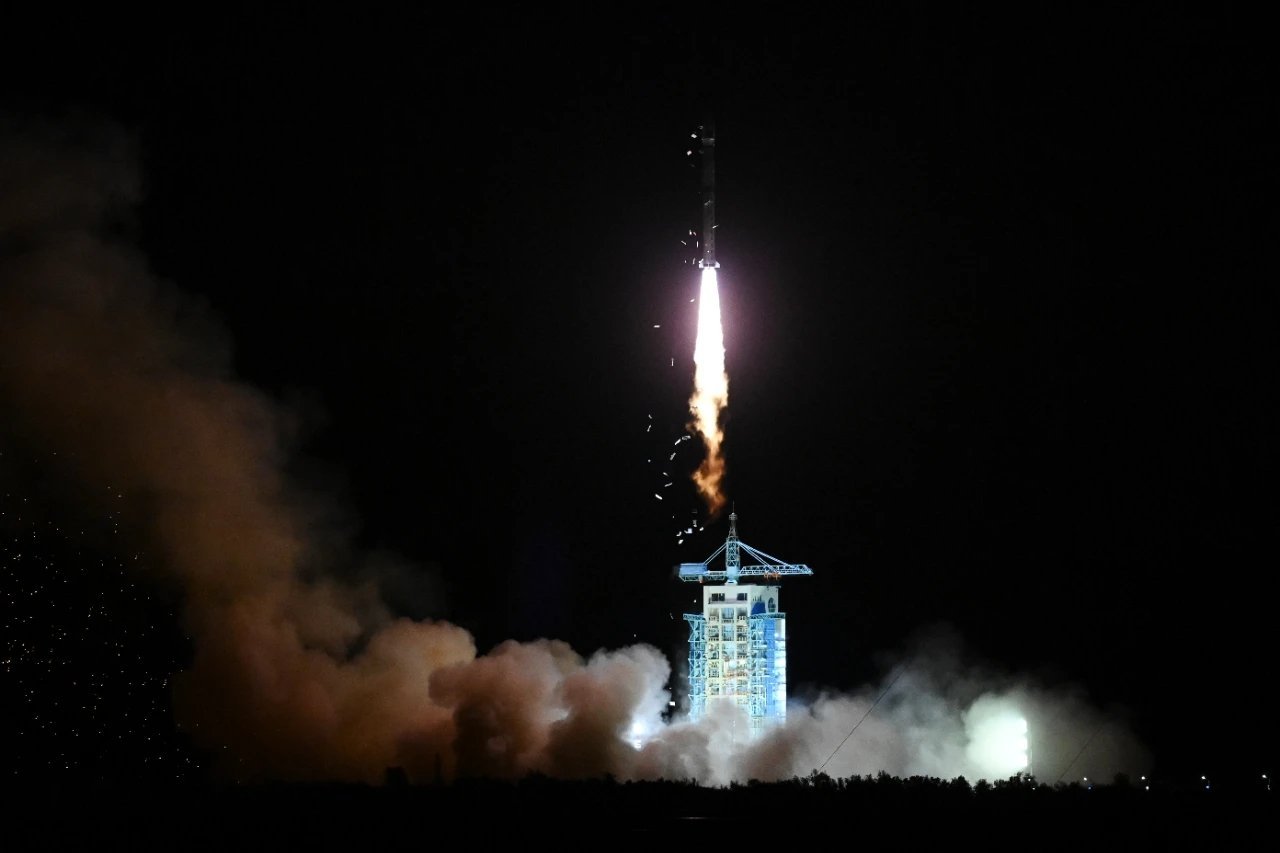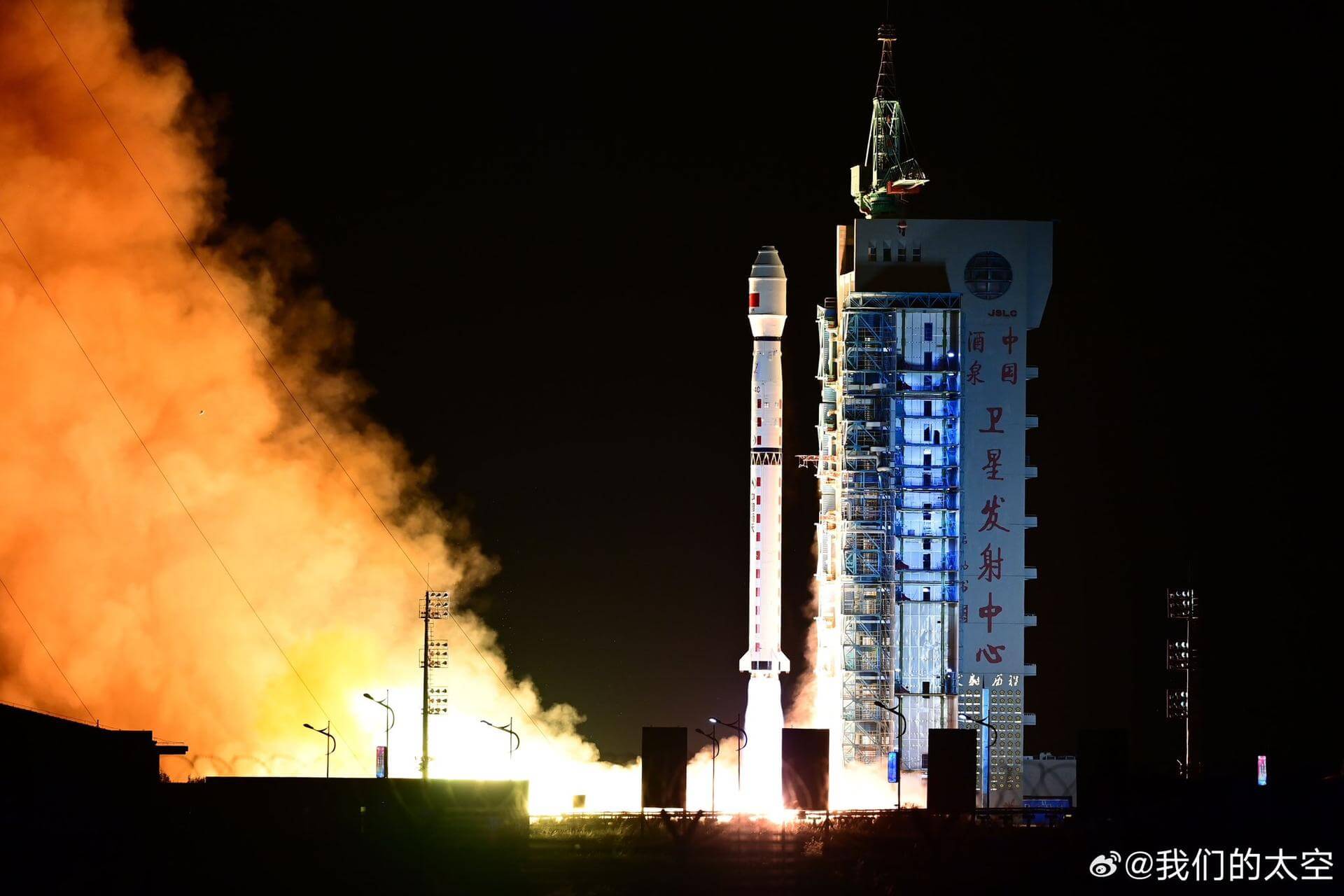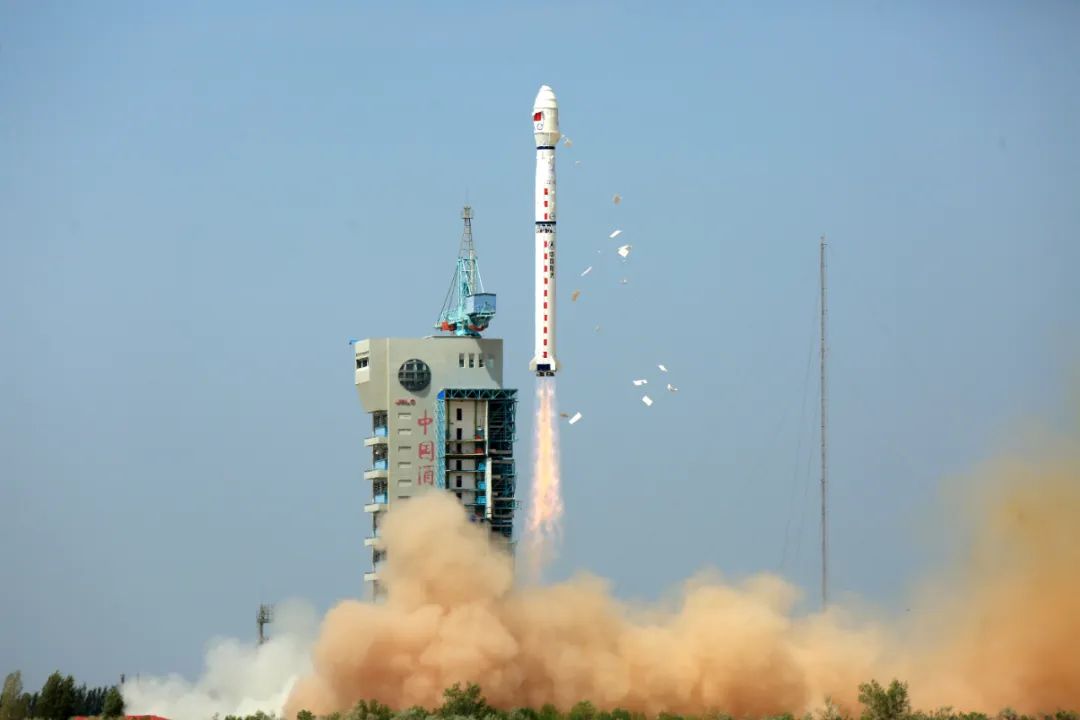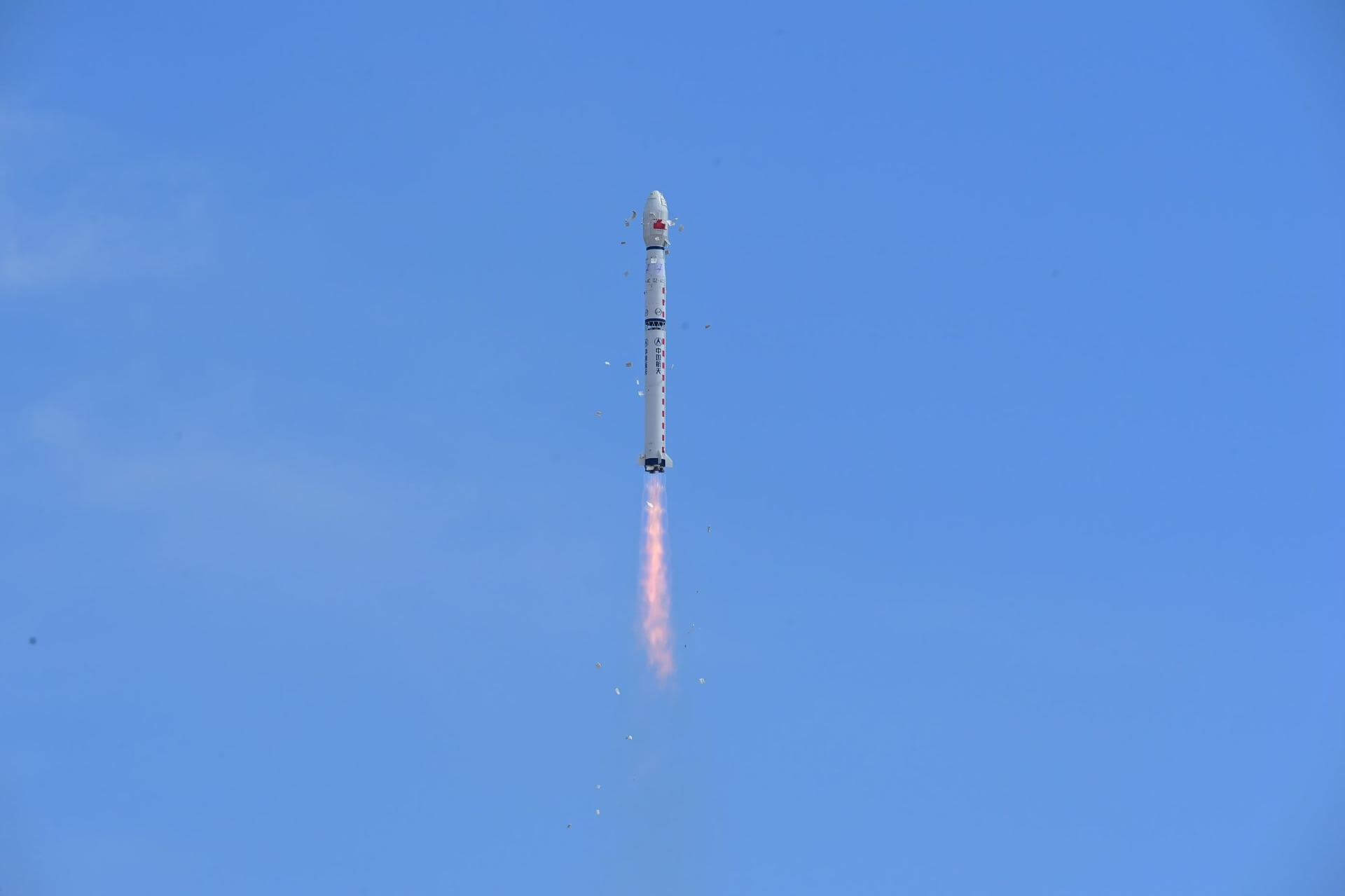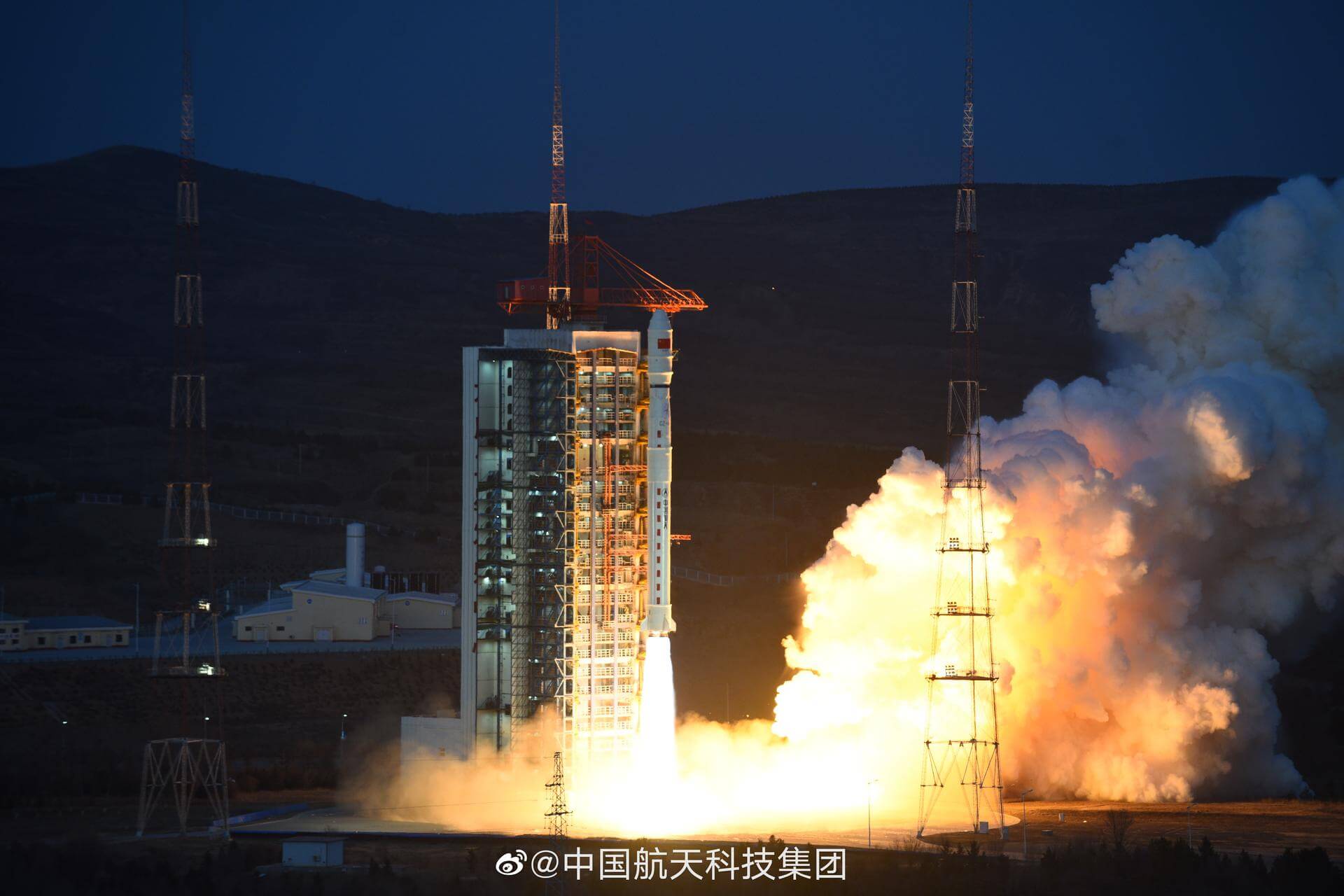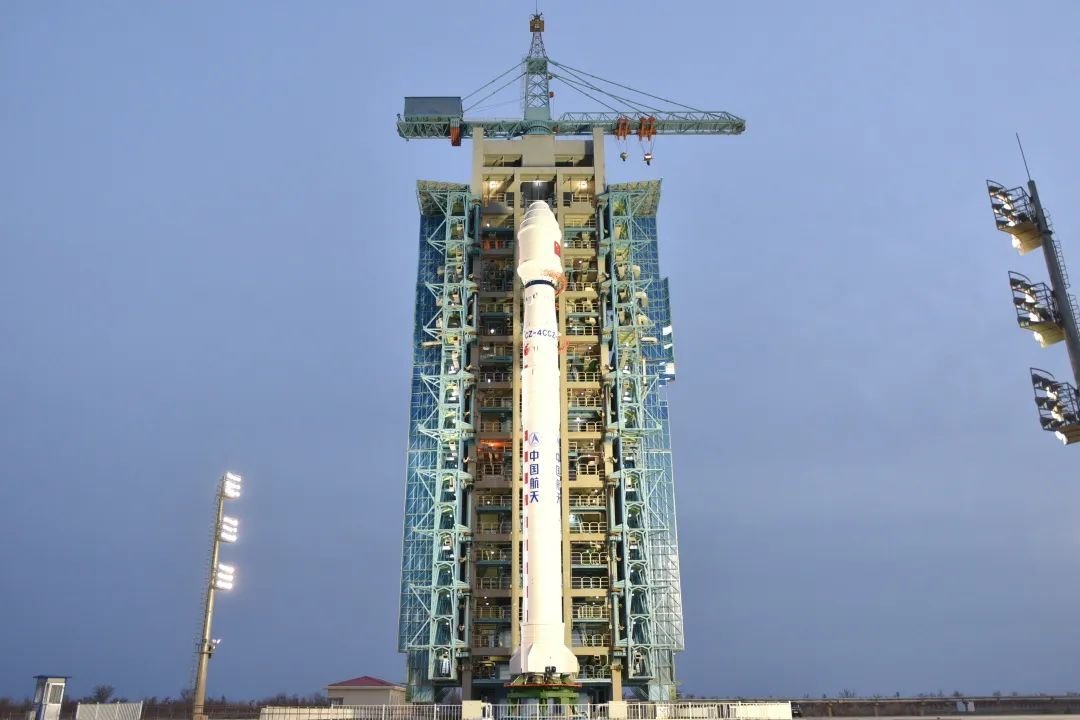
Long March 4C
ActiveChina Aerospace Science and Technology Corporation (CASC)
April 26, 2006
Description
The Long March 4C, also known as the Chang Zheng 4C, CZ-4C and LM-4C, previously designated Long March 4B-II, is a Chinese orbital carrier rocket. It is launched from the Jiuquan, Taiyuan Satellite Launch Centre and Xichangs, and consists of 3 stages. Long March 4C vehicles have been used to launch the Yaogan-1, Yaogan-3 SAR satellites and the Fengyun-3A polar orbiting meteorological satellite. On December 15, 2009 a Long March 4C was used to launch Yaogan 8.
Specifications
-
Stages
3 -
Length
― -
Diameter
― -
Fairing Diameter
― -
Launch Mass
― -
Thrust
―
Family
-
Name
Long March 4C -
Family
― -
Variant
C -
Alias
― -
Full Name
Long March 4C
Payload Capacity
-
Launch Cost
― -
Low Earth Orbit
― -
Geostationary Transfer
Orbit
― -
Direct Geostationary
― -
Sun-Synchronous Capacity
―
China Aerospace Science and Technology Corporation
Government
Chairman & President: Lei Fanpei
CASC 1999The China Aerospace Science and Technology Corporation (CASC) is the main contractor for the Chinese space program. It is state-owned and has a number of subordinate entities which design, develop and manufacture a range of spacecraft, launch vehicles, strategic and tactical missile systems, and ground equipment. It was officially established in July 1999 as part of a Chinese government reform drive, having previously been one part of the former China Aerospace Corporation. Various incarnations of the program date back to 1956.
Upcoming Spaceflights
Long March 4C | Unknown Payload
China Aerospace Science and Technology Corporation | ChinaTaiyuan Satellite Launch Center, People's Republic of China
Dec. 16, 2025, 3:15 a.m.
Long March 4C | Fengyun-3H
China Aerospace Science and Technology Corporation | ChinaJiuquan Satellite Launch Center, People's Republic of China
Sept. 26, 2025, 7:28 p.m.
Status: Launch Successful
Mission:
The Fengyun-3 (FY-3) series is the 2nd generation of Chinese polar-orbiting meteorological satellites, following on from the FY-1 series. The series has been developed collaboratively by CMA (Chinese Meteorological Administration) and CNSA (China National Space Administration). The FY-3 series’ objectives are to provide global measurements of 3-D temperature and moisture soundings, cloud and precipitation parameters, meteorological and hydrological events, biosphere anomalies and geophysical parameters in support of global change and climate monitoring.
Sun-Synchronous OrbitLong March 4C | Shiyan 28 B-02
China Aerospace Science and Technology Corporation | ChinaXichang Satellite Launch Center, People's Republic of China
Aug. 17, 2025, 8:55 a.m.
Long March 4C | Shiyan 28 B-01
China Aerospace Science and Technology Corporation | ChinaXichang Satellite Launch Center, People's Republic of China
July 3, 2025, 9:35 a.m.
Long March 4C | Gaofen-12 05
China Aerospace Science and Technology Corporation | ChinaJiuquan Satellite Launch Center, People's Republic of China
Oct. 15, 2024, 11:45 p.m.
Long March 4C | Shiyan 23
China Aerospace Science and Technology Corporation | ChinaJiuquan Satellite Launch Center, People's Republic of China
May 11, 2024, 11:43 p.m.
Long March 4C | Yaogan 33-04
China Aerospace Science and Technology Corporation | ChinaJiuquan Satellite Launch Center, People's Republic of China
Sept. 26, 2023, 8:15 p.m.
Long March 4C | Yaogan 33-03
China Aerospace Science and Technology Corporation | ChinaJiuquan Satellite Launch Center, People's Republic of China
Sept. 6, 2023, 6:14 p.m.
Long March 4C | Gaofen-12 04
China Aerospace Science and Technology Corporation | ChinaJiuquan Satellite Launch Center, People's Republic of China
Aug. 20, 2023, 5:45 p.m.
Long March 4C | Fengyun-3F
China Aerospace Science and Technology Corporation | ChinaJiuquan Satellite Launch Center, People's Republic of China
Aug. 3, 2023, 3:47 a.m.
Long March 4C | Yaogan 34-04
China Aerospace Science and Technology Corporation | ChinaJiuquan Satellite Launch Center, People's Republic of China
March 31, 2023, 6:27 a.m.
Long March 4C | Tianhui-6 A/B
China Aerospace Science and Technology Corporation | ChinaTaiyuan Satellite Launch Center, People's Republic of China
March 9, 2023, 10:41 p.m.
Long March 4C | Shiyan 20A & 20B
China Aerospace Science and Technology Corporation | ChinaJiuquan Satellite Launch Center, People's Republic of China
Dec. 12, 2022, 8:22 a.m.
Long March 4C | Yaogan 34-03
China Aerospace Science and Technology Corporation | ChinaJiuquan Satellite Launch Center, People's Republic of China
Nov. 15, 2022, 1:38 a.m.
Long March 2D | Shiyan 20C
China Aerospace Science and Technology Corporation | ChinaJiuquan Satellite Launch Center, People's Republic of China
Oct. 29, 2022, 1:01 a.m.
Long March 4C | Yaogan 33-02
China Aerospace Science and Technology Corporation | ChinaJiuquan Satellite Launch Center, People's Republic of China
Sept. 2, 2022, 11:44 p.m.
Long March 4C | Gaofen-12-03
China Aerospace Science and Technology Corporation | ChinaJiuquan Satellite Launch Center, People's Republic of China
June 27, 2022, 3:46 p.m.
Status: Launch Successful
Mission:
Gaofen is a series of civilian Earth observation satellites developed and launched for the China High-definition Earth Observation System (CHEOS), a state-sponsored programme aimed to develop a near-real time, all-weather, global surveillance network consisting of satellite, near-space (stratosphere) airships, and aerial observation platforms.
Sun-Synchronous OrbitLong March 4C | Daqi-1 (AEMS)
China Aerospace Science and Technology Corporation | ChinaTaiyuan Satellite Launch Center, People's Republic of China
April 15, 2022, 6:16 p.m.
Status: Launch Successful
Mission:
China’s first satellite dedicated to comprehensive monitoring of the atmospheric environment, named Daqi-1, also known as Atmospheric Environment Monitoring Satellite (AEMS) and developed by the Shanghai Academy of Spaceflight Technology (SAST) in Shanghai, is designed to operate in sun-synchronous orbit. Daqi-1 can monitor fine particle pollution like PM2.5, pollutant gases including nitrogen dioxide, sulfur dioxide and ozone, as well as carbon dioxide concentration. It combines both passive and active sensing, which can realize comprehensive monitoring of the atmospheric environment in a better way, according to a chief designer with SAST. The detection accuracy of fine particles and carbon dioxide column concentration by Daqi-1 has reached the international advanced level, the chief designer said. The atmospheric detection lidar deployed on the satellite is also the world's first that is capable of detecting both atmospheric aerosols and carbon dioxide.
Sun-Synchronous OrbitLong March 4C | Gaofen-3 03
China Aerospace Science and Technology Corporation | ChinaJiuquan Satellite Launch Center, People's Republic of China
April 6, 2022, 11:47 p.m.
Status: Launch Successful
Mission:
Gaofen (GF) is a series of Chinese civilian remote sensing satellites for the state-sponsored program China High-definition Earth Observation System (CHEOS). GF 3 features a multi-polarized C-band SAR at meter-level resolution, with designed lifespan of 8 years. The satellite is based on the CS-L3000B bus.
Sun-Synchronous OrbitLong March 4C | Yaogan 34-02
China Aerospace Science and Technology Corporation | ChinaJiuquan Satellite Launch Center, People's Republic of China
March 17, 2022, 7:09 a.m.
Long March 4C | L-SAR 01B
China Aerospace Science and Technology Corporation | ChinaJiuquan Satellite Launch Center, People's Republic of China
Feb. 26, 2022, 11:44 p.m.
Long March 4C | L-SAR 01A
China Aerospace Science and Technology Corporation | ChinaJiuquan Satellite Launch Center, People's Republic of China
Jan. 25, 2022, 11:44 p.m.
Long March 4C | Ziyuan 1-02E & CAS-9
China Aerospace Science and Technology Corporation | ChinaTaiyuan Satellite Launch Center, People's Republic of China
Dec. 26, 2021, 3:11 a.m.
Status: Launch Successful
Mission:
ZY-1 02E is a Chinese Earth observation satellite. The primary objective is to acquire high-resolution (5 meter) panchromatic and multispectral imagery for land resource surveys, disaster monitoring, forestry and ecological monitoring.
Sun-Synchronous OrbitLong March 4C | Gaofen-3 02
China Aerospace Science and Technology Corporation | ChinaJiuquan Satellite Launch Center, People's Republic of China
Nov. 22, 2021, 11:45 p.m.
Status: Launch Successful
Mission:
Gaofen (GF) is a series of Chinese civilian remote sensing satellites for the state-sponsored program China High-definition Earth Observation System (CHEOS). GF 3 features a multi-polarized C-band SAR at meter-level resolution, with designed lifespan of 8 years. The satellite is based on the CS-L3000B bus.
Sun-Synchronous OrbitLong March 4C | Gaofen-5-02
China Aerospace Science and Technology Corporation | ChinaTaiyuan Satellite Launch Center, People's Republic of China
Sept. 7, 2021, 3:01 a.m.
Status: Launch Successful
Mission:
Gaofen (GF) is a series of Chinese civilian remote sensing satellites for the state-sponsored program China High-definition Earth Observation System (CHEOS). GF 5 is configured with six types of payloads, including visible and short-wave infra hyper-spectral camera, spectral imager, greenhouse gas detector, atmospheric environment infrared detector at very high spectral resolution, differential absorption spectrometer for atmospheric trace gas, and multi-angle polarization detector, with designed lifespan of 8 years. The satellite is based on the SAST-5000B bus. The instruments are: * Advanced Hyperspectral Imager (AHSI) * Visual and Infrared Multispectral Sensor (VIMS) * Greenhouse-gases Monitoring Instrument (GMI) * Atmospheric Infrared Ultraspectral (AIUS) * Environment Monitoring Instrument (EMI) * Directional Polarization Camera (DPC)
Sun-Synchronous OrbitLong March 4C | Fengyun-3E
China Aerospace Science and Technology Corporation | ChinaJiuquan Satellite Launch Center, People's Republic of China
July 4, 2021, 11:28 p.m.
Long March 4C | Yaogan 34
China Aerospace Science and Technology Corporation | ChinaJiuquan Satellite Launch Center, People's Republic of China
April 30, 2021, 7:27 a.m.
Long March 4C | Gaofen-12-02
China Aerospace Science and Technology Corporation | ChinaJiuquan Satellite Launch Center, People's Republic of China
March 30, 2021, 10:45 p.m.
Status: Launch Successful
Mission:
Gaofen is a series of civilian Earth observation satellites developed and launched for the China High-definition Earth Observation System (CHEOS), a state-sponsored programme aimed to develop a near-real time, all-weather, global surveillance network consisting of satellite, near-space (stratosphere) airships, and aerial observation platforms.
Sun-Synchronous OrbitLong March 4C | Yaogan-31-04
China Aerospace Science and Technology Corporation | ChinaJiuquan Satellite Launch Center, People's Republic of China
March 13, 2021, 2:19 a.m.
Long March 4C | Yaogan-31-03
China Aerospace Science and Technology Corporation | ChinaJiuquan Satellite Launch Center, People's Republic of China
Feb. 24, 2021, 2:22 a.m.
Long March 4C | Yaogan-31-02
China Aerospace Science and Technology Corporation | ChinaJiuquan Satellite Launch Center, People's Republic of China
Jan. 29, 2021, 4:47 a.m.
Long March 4C | Yaogan-33(R)
China Aerospace Science and Technology Corporation | ChinaJiuquan Satellite Launch Center, People's Republic of China
Dec. 27, 2020, 3:44 p.m.
Long March 4C | Gaofen-12
China Aerospace Science and Technology Corporation | ChinaTaiyuan Satellite Launch Center, People's Republic of China
Nov. 27, 2019, 11:52 p.m.
Status: Launch Successful
Mission:
Gaofen is a series of civilian Earth observation satellites developed and launched for the China High-definition Earth Observation System (CHEOS), a state-sponsored programme aimed to develop a near-real time, all-weather, global surveillance network consisting of satellite, near-space (stratosphere) airships, and aerial observation platforms.
Long March 4C | Gaofen-10R
China Aerospace Science and Technology Corporation | ChinaTaiyuan Satellite Launch Center, People's Republic of China
Oct. 4, 2019, 6:51 p.m.
Status: Launch Successful
Mission:
Gaofen is a series of civilian Earth observation satellites developed and launched for the China High-definition Earth Observation System (CHEOS), a state-sponsored programme aimed to develop a near-real time, all-weather, global surveillance network consisting of satellite, near-space (stratosphere) airships, and aerial observation platforms. Gaofen-10R is a replacement satellite for the one lost in a 2016 failed launch.
Sun-Synchronous OrbitLong March 4C | Yaogan-33
China Aerospace Science and Technology Corporation | ChinaTaiyuan Satellite Launch Center, People's Republic of China
May 22, 2019, 10:49 p.m.
Long March 4C | Queqiao (Chang'e 4 relay satellite)
China Aerospace Science and Technology Corporation | ChinaXichang Satellite Launch Center, People's Republic of China
May 20, 2018, 9:28 p.m.
Status: Launch Successful
Mission:
Chang'e 4 is a Chinese lunar exploration mission that will incorporate an orbiter, a robotic lander and rover. The orbiter serves as a communications relay satellite. It will be placed into a halo orbit around the Earth-Moon L2 Lagrange point and is planned to support further missions to the far side of the Moon.
Lunar OrbitLong March 4C | Gaofen 5
China Aerospace Science and Technology Corporation | ChinaTaiyuan Satellite Launch Center, People's Republic of China
May 8, 2018, 6:28 p.m.
Status: Launch Successful
Mission:
Gaofen is a series of civilian Earth observation satellites developed and launched for the China High-definition Earth Observation System (CHEOS), a state-sponsored programme aimed to develop a near-real time, all-weather, global surveillance network consisting of satellite, near-space (stratosphere) airships, and aerial observation platforms. Based on the SAST5000B bus, Gaofen 5 will carry six types of payloads, including visible and short-wave infra hyper-spectral camera, spectral imager, greenhouse gas detector, atmospheric environment infrared detector at very high spectral resolution, differential absorption spectrometer for atmospheric trace gas, and multi-angle polarization detector. The satellite has a designed life of 8 years. It is to be launched atop of a Long March 4C to a 705km Sun Syncronous Orbit (SSO).
Sun-Synchronous OrbitLong March 4C | 3 x Yaogan-31-01
China Aerospace Science and Technology Corporation | ChinaJiuquan Satellite Launch Center, People's Republic of China
April 10, 2018, 4:25 a.m.
Long March 4C | Gaofen 1-02, 1-03 & 1-04
China Aerospace Science and Technology Corporation | ChinaTaiyuan Satellite Launch Center, People's Republic of China
March 31, 2018, 3:22 a.m.
Long March 4C | Fengyun-3D
China Aerospace Science and Technology Corporation | ChinaTaiyuan Satellite Launch Center, People's Republic of China
Nov. 14, 2017, 6:35 p.m.
Status: Launch Successful
Mission:
Fengyun-3D (also known as FY-3D) is a polar orbiting meteorological satellite. It is tasked with ocean and ice monitoring, as well as studying atmospheric chemistry and space weather. The satellite is expected to operate for 5 years.
Sun-Synchronous OrbitLong March 4C | Gaofen 10
China Aerospace Science and Technology Corporation | ChinaTaiyuan Satellite Launch Center, People's Republic of China
Aug. 31, 2016, 6:55 p.m.
Status: Launch Failure
Mission:
Gaofen is a series of civilian Earth observation satellites developed and launched for the China High-definition Earth Observation System (CHEOS), a state-sponsored programme aimed to develop a near-real time, all-weather, global surveillance network consisting of satellite, near-space (stratosphere) airships, and aerial observation platforms.
Sun-Synchronous OrbitLong March 4C | Gaofen 3
China Aerospace Science and Technology Corporation | ChinaTaiyuan Satellite Launch Center, People's Republic of China
Aug. 9, 2016, 10:55 p.m.
Long March 4C | Yaogan-29
China Aerospace Science and Technology Corporation | ChinaTaiyuan Satellite Launch Center, People's Republic of China
Nov. 26, 2015, 9:24 p.m.
Long March 4C | Yaogan-27
China Aerospace Science and Technology Corporation | ChinaTaiyuan Satellite Launch Center, People's Republic of China
Aug. 27, 2015, 2:31 a.m.
Long March 4C | Yaogan 25A, Yaogan 25B, Yaogan 25C
China Aerospace Science and Technology Corporation | ChinaJiuquan Satellite Launch Center, People's Republic of China
Dec. 10, 2014, 7:33 p.m.
Long March 4C | Yaogan-22
China Aerospace Science and Technology Corporation | ChinaTaiyuan Satellite Launch Center, People's Republic of China
Oct. 20, 2014, 6:31 a.m.
Long March 4C | Yaogan 20A, Yaogan 20B, Yaogan 20C
China Aerospace Science and Technology Corporation | ChinaJiuquan Satellite Launch Center, People's Republic of China
Aug. 9, 2014, 5:45 a.m.
Long March 4C | Yaogan 19
China Aerospace Science and Technology Corporation | ChinaTaiyuan Satellite Launch Center, People's Republic of China
Nov. 20, 2013, 3:31 a.m.
Long March 4C | Fengyun-3C
China Aerospace Science and Technology Corporation | ChinaTaiyuan Satellite Launch Center, People's Republic of China
Sept. 23, 2013, 3:07 a.m.
Long March 4C | Yaogan 17A, B & C
China Aerospace Science and Technology Corporation | ChinaJiuquan Satellite Launch Center, People's Republic of China
Sept. 1, 2013, 7:16 p.m.
Long March 4C | Shijian 15, Shiyan 7 & ChuangXin 3
China Aerospace Science and Technology Corporation | ChinaTaiyuan Satellite Launch Center, People's Republic of China
July 19, 2013, 11:37 p.m.
Long March 4C | Yaogan 16A, Yaogan 16B, Yaogan 16C
China Aerospace Science and Technology Corporation | ChinaJiuquan Satellite Launch Center, People's Republic of China
Nov. 25, 2012, 4:06 a.m.
Long March 4C | Yaogan 15
China Aerospace Science and Technology Corporation | ChinaTaiyuan Satellite Launch Center, People's Republic of China
May 29, 2012, 7:31 a.m.
Long March 4C | Feng Yun-3B
China Aerospace Science and Technology Corporation | ChinaTaiyuan Satellite Launch Center, People's Republic of China
Nov. 4, 2010, 6:37 p.m.
Long March 4C | Yaogan-10
China Aerospace Science and Technology Corporation | ChinaTaiyuan Satellite Launch Center, People's Republic of China
Aug. 9, 2010, 10:49 p.m.
Long March 4C | Yaogan-9
China Aerospace Science and Technology Corporation | ChinaJiuquan Satellite Launch Center, People's Republic of China
March 5, 2010, 4:55 a.m.
Long March 4C | Yaogan Weixing 8
China Aerospace Science and Technology Corporation | ChinaTaiyuan Satellite Launch Center, People's Republic of China
Dec. 15, 2009, 2:31 a.m.
Long March 4C | Feng Yun 3A
China Aerospace Science and Technology Corporation | ChinaTaiyuan Satellite Launch Center, People's Republic of China
May 27, 2008, 3:02 a.m.
Long March 4C | Yaogan Weixing 3
China Aerospace Science and Technology Corporation | ChinaTaiyuan Satellite Launch Center, People's Republic of China
Nov. 11, 2007, 10:48 p.m.
Long March 4C | Yaogan Weixing 1
China Aerospace Science and Technology Corporation | ChinaTaiyuan Satellite Launch Center, People's Republic of China
April 26, 2006, 10:48 p.m.
Status: Launch Successful
Mission:
The Yaogan 1 (Remote Sensing Satellite-1) government remote sensing satellite, likely also used as a military reconnaissance satellite, was launched by CZ-4C rocket from China's Taiyuan space center on 26 April 2006. It is China's first space-based synthetic aperture radar (SAR) system. The military designation of the satellite is Jian Bing-5 (JB-5). The whole development project was funded by the PLA.
Sun-Synchronous OrbitElectron
Raise and Shine (RAISE-4)
Rocket Lab Launch Complex 1B - Rocket Lab Launch Complex 1, Mahia Peninsula, New ZealandRAISE-4 (RApid Innovative payload demonstration Satellite-4) is a Japan Aerospace Exploration Agency (JAXA) satellite for on-orbit demonstrations of …
Kuaizhou 11
DEAR-5
Launch Area 95A - Jiuquan Satellite Launch Center, People's Republic of ChinaDEAR-5 is a commercial in-orbit payload and micro-gravity experiments hosting spacecraft developed by Chinese commercial company AZSPACE for various …
Long March 12
SatNet LEO Group 16
Commercial LC-2 - Wenchang Space Launch Site, People's Republic of ChinaA batch of Low Earth Orbit communication satellites for the Chinese state owned SatNet constellation operated by the China Satellite Network Group. …
Falcon 9
Starlink Group 6-90
Space Launch Complex 40 - Cape Canaveral SFS, FL, USAA batch of 29 satellites for the Starlink mega-constellation - SpaceX's project for space-based Internet communication system.
Falcon 9
Starlink Group 15-11
Space Launch Complex 4E - Vandenberg SFB, CA, USAA batch of 27 satellites for the Starlink mega-constellation - SpaceX's project for space-based Internet communication system.
